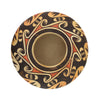
Fannie Nampeyo (1900-1987) Biography
Fannie Nampeyo is the youngest of three daughters of the famous Old Lady Nampeyo of Hano, the grand matriarch of Hopi pottery. Fannie was born in the Hopi-Tewa Corn Clan home atop First Mesa. Fannie’s birth name was Popongua or Popong-Mana, which means “picking piñons,” by the older women of her father Lesou’s family.
Later on, she was given the name Fannie by either missionaries or health-care workers. Fannie inherited her mother’s role as the matriarch of the Corn Clan, a very important and time-consuming ceremonial position.
Fannie began making pottery in her early 20s, and was among the most skilled potters of her generation. Her signature design was the migration or bird wing design, which was revived by her mother. She also assisted her near-blind mother by painting her pots that Nampeyo was still able to expertly form.
Fannie received the First Place Blue Ribbon in 1961 at the Museum of Northern Arizona’s Hopi Craftsman Exhibition. Fannie’s pottery can be found in museums around the world to include the Cleveland Museum of Art, and the University of Oklahoma’s Fred Jones, Jr. Museum of Art.